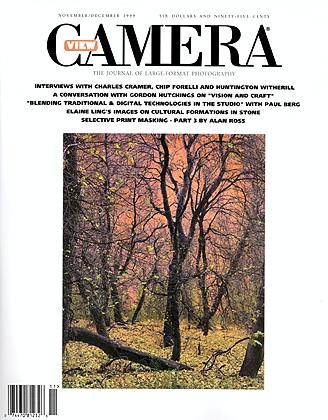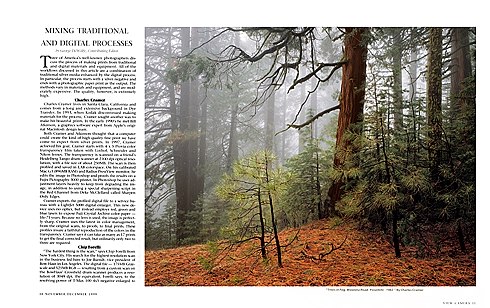Article from the The November/December 1999 Issue of View Camera Magazine by George DeWolfe:
Three of America's well-known photographers discuss the process of making prints from traditional and digital materials and equipment. All of the workflows discussed in this article are a combination of traditional silver media enhanced by the digital process. In particular, the process starts with a silver negative and ends with a photographic paper print as the output. The methods vary in materials and equipment, and are moderately expensive. The quality, however, is extremely high.
Charles Cramer
Charles Cramer comes from a long and extensive background in Dye Transfer. In 1993, when Kodak discontinued making materials for the process, Cramer sought another way to make his beautiful prints. In the early 1990's he met Bill Atkinson, a graphics software expert from Apple's original Macintosh design team.
Both Cramer and Atkinson thought that a computer could create the kind of high quality fine print we have come to expect from silver prints. In 1997, Cramer achieved his goal. Cramer starts with 4x5 Provia color transparency film taken with Linhof, Schneider and Nikon lenses. The transparency is scanned on a friend's Heidelberg Tango drum scanner at 2100 dpi optical resolution, with a file size of about 250MB. The scan is then profiled and saved in LAB colorspace. On his calibrated Mac G3 (896MB RAM) and Radius PressView monitor, he edits the image in Photoshop and proofs the results on a Fujix Pictrography 3000 printer. In Photoshop he uses adjustment layers heavily to keep from degrading the image, in addition to using a special sharpening script in the Lightness Channel from Deke McClelland called Sharpen Only Edges.
Cramer exports the profiled digital file to a service bureau with a LightJet 5000 digital enlarger. This new device uses no optics, but instead employs red, green and blue lasers to expose Fuji Crystal Archive color paper---life-71 years. Because no lens is used, the image is perfectly sharp. Cramer uses the latest in color management, from the original scans, to proofs, to final prints. These profiles insure a faithful reproduction of the colors in the transparency. Cramer says it can take as many as 17 prints to get the final corrected result, but ordinarily only two to three are required.
Images from the Magazine


